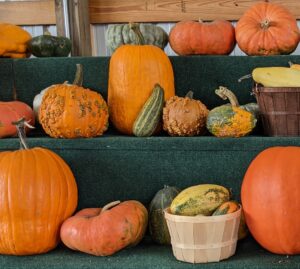Saving Gourd and Pumpkin Seeds!
go.ncsu.edu/readext?824405
en Español / em Português
El inglés es el idioma de control de esta página. En la medida en que haya algún conflicto entre la traducción al inglés y la traducción, el inglés prevalece.
Al hacer clic en el enlace de traducción se activa un servicio de traducción gratuito para convertir la página al español. Al igual que con cualquier traducción por Internet, la conversión no es sensible al contexto y puede que no traduzca el texto en su significado original. NC State Extension no garantiza la exactitud del texto traducido. Por favor, tenga en cuenta que algunas aplicaciones y/o servicios pueden no funcionar como se espera cuando se traducen.
Português
Inglês é o idioma de controle desta página. Na medida que haja algum conflito entre o texto original em Inglês e a tradução, o Inglês prevalece.
Ao clicar no link de tradução, um serviço gratuito de tradução será ativado para converter a página para o Português. Como em qualquer tradução pela internet, a conversão não é sensivel ao contexto e pode não ocorrer a tradução para o significado orginal. O serviço de Extensão da Carolina do Norte (NC State Extension) não garante a exatidão do texto traduzido. Por favor, observe que algumas funções ou serviços podem não funcionar como esperado após a tradução.
English
English is the controlling language of this page. To the extent there is any conflict between the English text and the translation, English controls.
Clicking on the translation link activates a free translation service to convert the page to Spanish. As with any Internet translation, the conversion is not context-sensitive and may not translate the text to its original meaning. NC State Extension does not guarantee the accuracy of the translated text. Please note that some applications and/or services may not function as expected when translated.
Collapse ▲Gourds and pumpkins used for fall décor contain seeds that can be collected and planted in your garden next summer. Seed saving can save you a little bit of money, but the real benefit to seed saving is the preservation of unique plants. Saving seed from gourds and pumpkins is an exciting experience since many have likely been cross pollinated and as a result seeds saved from these plants will produce a variety of fruit displaying various colors, shapes, and sizes. Half the fun of saving seeds from gourds and pumpkins is to see this show of diversity in your garden.
 When seed saving, it is important to always select seed from high-quality, healthy plants. It is also important to select for desirable traits such as appearance, size, and durability. Never collect seeds from diseased plants; some diseases can be carried on seeds that can later infect your garden. Seeds should be harvested when they are fully mature. Knowing the proper time to harvest your seeds will come with experience, however here are some simple seed saving steps for both gourds and pumpkins to help you get started.
When seed saving, it is important to always select seed from high-quality, healthy plants. It is also important to select for desirable traits such as appearance, size, and durability. Never collect seeds from diseased plants; some diseases can be carried on seeds that can later infect your garden. Seeds should be harvested when they are fully mature. Knowing the proper time to harvest your seeds will come with experience, however here are some simple seed saving steps for both gourds and pumpkins to help you get started.
Saving Gourd Seeds: Gourd seeds can be saved from fresh gourds using the same steps given below for the pumpkin or seeds can be saved from dried gourds. Saving seed from dried gourds allows you to use the shell for craft purposes as well as seed saving.
- Gourd should be cleaned with soap and water, dried, and wiped with 70% rubbing alcohol or 10% bleach solution.
- Place clean, dry gourd in a dark, well-ventilated area in a shallow tray. Do not allow gourds to touch each other.
- If any mold appears as the gourd is curing, wipe the area clean with alcohol or bleach and allow it to continue drying.
- Periodically turn the gourd during the drying process.
- Curing can take 1 to 6 months depending on the type and size of the gourd. Curing is complete when the gourd becomes light and seeds are rattling inside.
- Cut open the stem end of the gourd and shake out the seeds.
- Remove dry pulp from around the seeds and store seeds in paper envelopes.
Saving Pumpkin Seeds:
- Remove the seeds from the pumpkin with a spoon.
- Wash and rinse the seeds using warm, not hot, soapy water until all pulp is removed.
- Drain seeds in a strainer.
- Spread seed out evenly across a screen, an old window screen works great.
- Mix and turn over each seed for the first two days.
- Allow the seeds to air dry in a cool, dry area for a minimum of three weeks.
- Once the seeds are dry, package them in paper envelopes. Do not use plastic bags or the seeds will mold and rot.
All seeds should be stored in a cool, dark, dry place such as the refrigerator. Before storing your seed, properly label each of your envelopes with the cultivar name and date saved. Properly stored seeds can stay viable for several years; however the longer seeds are stored, the lower the percentage of germination. Gourds and pumpkins are typically planted in WNC around May 25th through June 30th.




